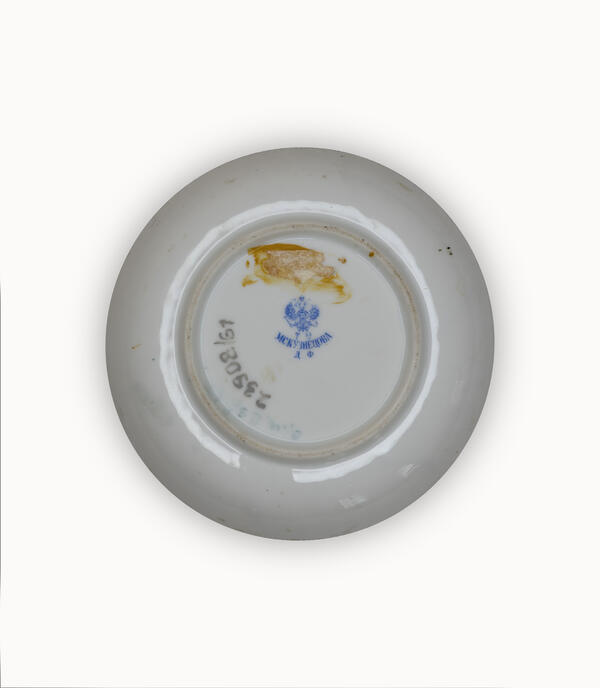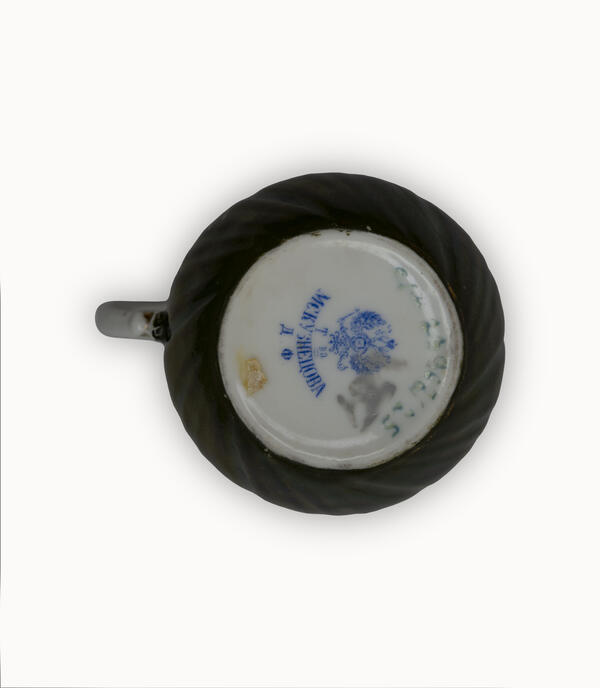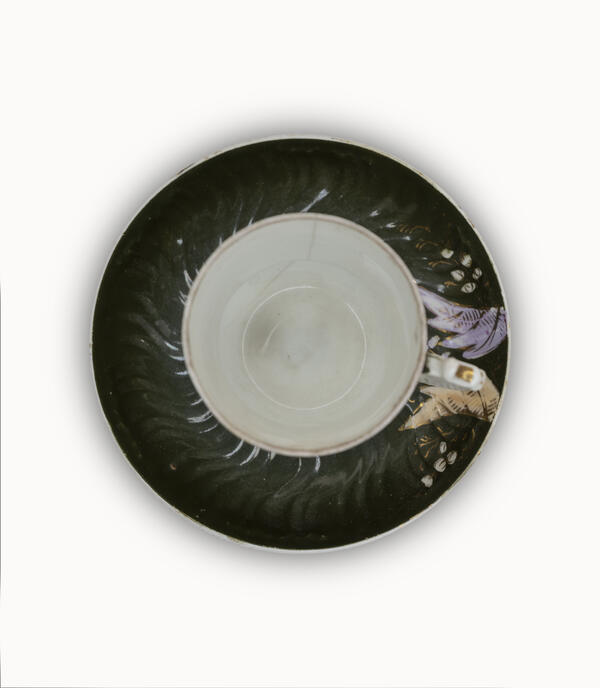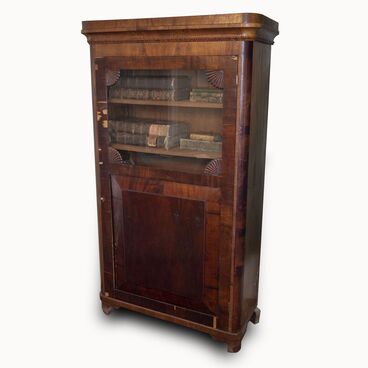This porcelain сup and saucer set, covered with dark green glaze and embellished with a floral pattern, was purchased by a resident of pre-revolutionary Turinsk at the famous All-Russian Irbit Fair in 1910. It was donated to the Turinsk Decembrists House Museum in 1977.
For over 100 years, the Kuznetsov Porcelain Factory was a leading manufacturer of porcelain and faience in Russia.
In the early 19th century, Yakov Kuznetsov and his sons built a small manufactory and hired Gzhel craftsmen. The sons supervised the production. The stamp “Factory of the Kuznetsov brothers” was put on each product, and the quality of items was under strict regulation. Over time, the demand for the Kuznetsov chinaware began to grow.
Soon, the Kuznetsov production was expanded. A suitable place for it was found near the village of Dulyovo, leading to the establishment of the famous Dulyovo porcelain factory. The secrets of Kuznetsov dishware were passed down through the generations. Each production stage was controlled by single-discipline specialists.
On September 29, 1887, Matvey Kuznetsov, the great-grandson of Yakov Kuznetsov, organized the “Matvey Kuznetsov Partnership for the Production of Porcelain, Earthenware and Majolica”. Soon he acquired the Gardner porcelain manufactory, which was considered the best one in Russia. Kuznetsov also received the right to use all its models, drawings, and samples, as well as to put the Gardner stamp on the dishware next to the list of its awards. Matvey Kuznetsov set great store not only by the quality of the items but also their art value and paid great attention to painting. He even sent some of his employees to study at the Moscow Stroganov Drawing School, covering their tuition costs in full. It is known that Kuznetsov collaborated with Mikhail Vrubel. The great importance of the Kuznetsov factory is proven by the fact that it was granted the honorary right to use the symbol of the state — the image of a double-headed eagle — on its products by the imperial court. Matvey Kuznetsov was even awarded the title of Supplier of His Imperial Majesty Court.
Matvey Kuznetsov died in 1911 when his porcelain and faience empire was thriving, and his descendants were eager to carry on with developing the family business. However, after the Russian Revolution in 1917, the Kuznetsovs lost all their factories.
For over 100 years, the Kuznetsov Porcelain Factory was a leading manufacturer of porcelain and faience in Russia.
In the early 19th century, Yakov Kuznetsov and his sons built a small manufactory and hired Gzhel craftsmen. The sons supervised the production. The stamp “Factory of the Kuznetsov brothers” was put on each product, and the quality of items was under strict regulation. Over time, the demand for the Kuznetsov chinaware began to grow.
Soon, the Kuznetsov production was expanded. A suitable place for it was found near the village of Dulyovo, leading to the establishment of the famous Dulyovo porcelain factory. The secrets of Kuznetsov dishware were passed down through the generations. Each production stage was controlled by single-discipline specialists.
On September 29, 1887, Matvey Kuznetsov, the great-grandson of Yakov Kuznetsov, organized the “Matvey Kuznetsov Partnership for the Production of Porcelain, Earthenware and Majolica”. Soon he acquired the Gardner porcelain manufactory, which was considered the best one in Russia. Kuznetsov also received the right to use all its models, drawings, and samples, as well as to put the Gardner stamp on the dishware next to the list of its awards. Matvey Kuznetsov set great store not only by the quality of the items but also their art value and paid great attention to painting. He even sent some of his employees to study at the Moscow Stroganov Drawing School, covering their tuition costs in full. It is known that Kuznetsov collaborated with Mikhail Vrubel. The great importance of the Kuznetsov factory is proven by the fact that it was granted the honorary right to use the symbol of the state — the image of a double-headed eagle — on its products by the imperial court. Matvey Kuznetsov was even awarded the title of Supplier of His Imperial Majesty Court.
Matvey Kuznetsov died in 1911 when his porcelain and faience empire was thriving, and his descendants were eager to carry on with developing the family business. However, after the Russian Revolution in 1917, the Kuznetsovs lost all their factories.






